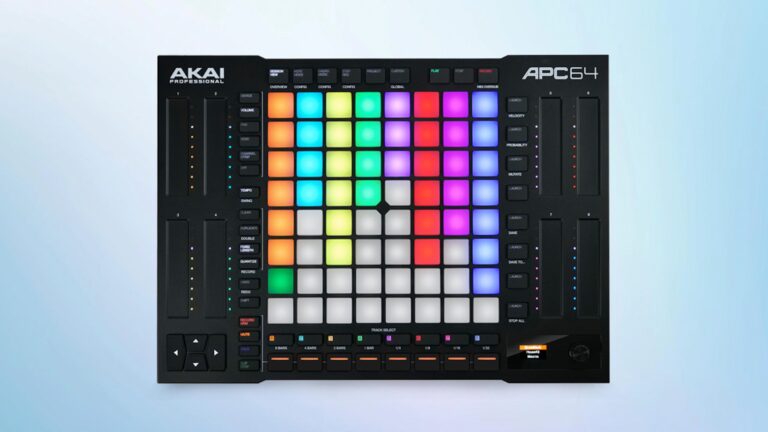“The inevitable question is whether the APC64 is the optimal choice for those seeking an Ableton-Live-specific controller.”
It sort of boggles my mind that later this year, I’ll celebrate two decades as a user of Ableton Live, the innovative DAW (digital audio workstation) software that originally debuted in 2001.
A lot has happened between the product’s market entry (and when I started using it in 2004), and today – notably, the release of hardware tightly integrated with, and designed to help make the most of Live. It all started in 2009 with a collaboration between Ableton and Akai Professional, resulting in the APC40.
Since then, the basic concept of the APC40 has been extended and reimagined in various ways and at various times. For one, Ableton started producing its own hardware, the Push series, the first of which (introduced in 2013) was itself designed in collaboration with Akai Professional (an inMusic brand). Both companies have continued to innovate; just recently, in fact, Ableton introduced its latest Push controller, the Push 3.
But Akai Professional has itself continued to improve and expand the APC family with a mix of controllers much like the original APC40 in form, along with keyboard controllers as well. The company’s latest offering in the series is the APC64, introduced late last year. After getting my hands on one, I’ve been spending time with it in my studio alongside Live.
Controls Abound
At its core, the APC64 features the typical grid of backlit pads. In the case of the APC64, there are (as you might have guessed) 64 of them, all RGB-illuminated and offering velocity sensitivity and polyphonic aftertouch. This 8×8 pad matrix, as you’d expect, pulls double duty; you can play notes or chords, and trigger percussion samples in Live’s Drum Racks, as well as trigger clips in Live’s Session View.
On the left and right sides of the unit, there are eight assignable touch-strip faders with nine RGB LEDs for each one that indicate relative level. They can be used for various functions, from controlling volume or pan, to controlling effects or macros. Rather like the pads, I might have preferred actual faders for better accuracy and control, but the advantage of the strips is a top surface almost completely devoid of “stuff” that projects upward, a plus for portability, and likely durability as well.
More than 50 additional buttons surrounding the main grid provide a wide array of functions for the APC64 itself, as well as for controlling Live. The extensive use of illumination and color on these buttons, and throughout, provides clear visual feedback as you navigate the unit in your own production workflow.
Interestingly, the APC64 also offers an internal eight-track, 32-step sequencer that can be used standalone. The primary use case seems to be to provide control of external sound devices outside of the DAW environment through either MIDI, or through the eight on-board CV/gate outputs. This delivers the flexibility to control just about any external sound-generating device you want to throw at it, from modern synths to vintage drum machines to your favorite Eurorack modules. Once you’ve come up with the perfect sequence to get your project started, it can be transferred to Live for use within the DAW.
Those MIDI connections, by the way? You get two outs, and one in, and they use 1/8-inch connectors on the backplane of the unit; adapter cables for standard MIDI 5-pin DIN are included.
In addition to all the buttons and pads and touch strips, the unit also includes a tiny color LCD display on the top panel with an adjacent knob for basic navigation and configuration. Given its extraordinarily small size and somewhat cumbersome interface, however, I found it to be pretty much the only disappointment of the APC64’s design. (Perhaps my expectations were skewed by the Push 2 controller I’ve had in my home studio for years now, leaving me wishing for a bigger screen and more capability.)
One benefit of the APC64 is that it doesn’t require any sort of external power supply, and the inconvenient “wall-wart” bricks that it usually entails. Instead, it runs fully off USB power alone, provided through the unit’s USB-C connector.
Lastly, the APC64 comes bundled with Ableton Live Lite to help get new users started. There’s an easy upgrade path to paid versions of the software, of course.
In Use
Hands-on, as I expected, I found the APC64 to be exceptionally easy to use. Like any new controller, there’s a learning curve to understand how to set up the device properly, and it takes time to develop the muscle memory to use it effectively as part of a production or performance workflow. In that regard, the APC64 is no easier, nor more difficult, than other options on the market. To Akai Professional’s credit, they provide on their website a series of tutorial videos under the “APC Academy” banner that make everything much easier to understand.
Perhaps my only criticism is that the APC64’s pads strike me as a bit of a compromise in terms of usability when it comes to getting the sort of note velocities I’m after, and as a result, the subtlety of expression can suffer a bit. (I admittedly prefer a standard music keyboard.) With my fingers, anyway, the hits are invariably too hard, or too soft, and only occasionally where I really want them.
In this regard, however, the APC64 is no different than other similarly designed controllers; I’ve struggled with this on the Push 2 as well. I’d also suggest that it’s more important to get the right notes down, as velocities and other subtleties can always be adjusted in the DAW after the fact.
I suppose the inevitable question is whether the APC64 is the optimal choice for those seeking an Ableton-Live-specific controller, especially against other options including Ableton’s own new Push 3. The answer is that it’s a bit of an apple-to-oranges comparison. The APC64 offers a lot of bang for a pretty modest buck; with a street price of just under $400, it’ll provide both a solid platform for musical experimentation and a great way to drive home just how impractical a computer mouse is for certain operations in a DAW.
Ableton’s Push 3, on the other hand, comes in two flavors that start at more than twice the cost. Obviously, you get a lot for the extra spend, but whether you need (or can justify) those capabilities is an entirely separate question.
Conclusions
Akai Professional’s new APC64 is a solid addition to any Ableton Live user’s studio or performance environment. With a solid feature set, plenty of options for creative musical experimentation, the ability to make Live easier to use across myriad workflows, and great portability — all at an affordable price — it seems like a rather obvious choice for any serious Ableton Live user.


